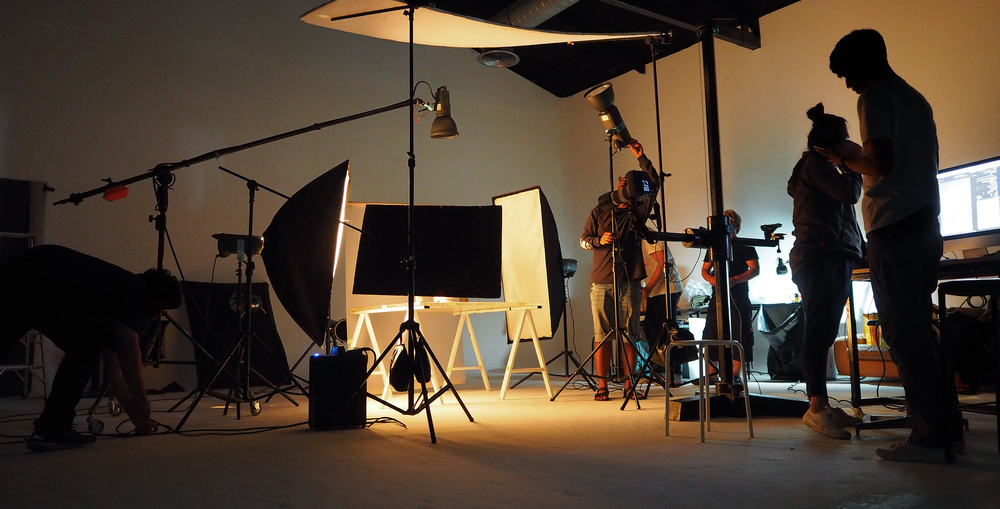
What to Pay Attention to When Buying a Computer for Video Editing
In order to edit top-notch videos, your computer needs to be ready for the work. And we’ll tell you everything you’ll need.

What will we see in this post
One indispensable item for any editor is a good video editing computer. It’s very important that professionals know how to pick the right one since many editing programs are heavy and require powerful machines to run smoothly. Therefore, in today’s article, we’re going to show you everything you need in a computer for this purpose. We’re going to explain the key components of a video editing computer and provide you with tips on a few brands and products.
Essential components in a video editing computer
Below, you will see the importance of each component, the ideal capacity of each one, and what they are used for. Read on!
1. HD
A hard drive (HD) is the computer’s memory. In its configuration, it’s represented by the highest number. For example: If a PC has 8 GB/500 GB, this means that it has 8 GB of RAM and a 500 GB HD.
RAM memory is short-term digital storage, which is lost when the machine is shut down. On the other hand, HD is the memory that is not lost when the PC is turned off that is responsible for storing programs and files.
Ideally, a video editing computer should be a hybrid of HD and SSD – Solid State Drive. This combination is the solution for the system to run faster, although it costs a little more.
Depending on the editing frequency, the minimum memory requirement should be 500 GB. But if you have an intense work routine, you should get a computer for video editing with a capacity of at least 1 TB.
If all this space isn’t enough, a good alternative is to use external HDs or cloud storage to save your content. A good HD needs to have a large storage space since it allows for faster data transmission.
2. RAM Memory
As mentioned above, unlike the HD, RAM memory doesn’t store information permanently. Besides speeding up computer use, this component is a key part in rendering, since it allows you to work with more editing programs at the same time.
This is because the larger the RAM memory, the more programs can be used simultaneously without overloading the machine, streamlining your work.
Again, RAM memory configurations must meet your needs. Therefore, if you keep a regular work routine, a PC with 8 GB of RAM will work just fine.
But, for those days when there’s a high demand, a video editing computer with 16 GB of RAM is ideal.
3. Processor
In a nutshell, the processor is responsible for speeding up, addressing, preparing or solving the data received. And in terms of editing software, the processor is used full time, especially when rendering.
The more powerful the computer’s processor is for video editing, the faster the execution of the programs will be.
So, for heavier edits, the ideal processor is the Intel i7, with the latest generation, which is constantly updated.
It is also possible to work with i3 and i5 processors. However, keep in mind that this will depend a lot on the application. Another thing is that it will require a higher quality of the content since you won’t be able to add many elements to your video.
4. Video card
A video card is the computer component responsible for controlling and managing the video display functions on the monitor’s screen.
This component serves more to unburden the CPU in certain applications. In editing software that is more robust, several special effect options can be applied by using the video card instead of the CPU.
This is why there are dedicated and onboard video cards. Dedicated cards are used exclusively for heavy graphic work, such as games and video editing.
In the case of onboard cards, there is no actual video card. What the computer has is a GPU, which is a graphic processor that executes the functions of a video card. A PC with these configurations is ideal for basic activities.
But obviously, editing professionals should purchase a computer for video editing with a dedicated video card.
And in this case, for heavier work, the best option is an 8 GB GTX1080 card or at least a 2 GB GTX 1050 card.
5. Monitor
This is certainly the best-known component and doesn’t require a detailed introduction. It’s through the monitor that you’re able to visualize everything in the right shapes and colors, which is indispensable when it comes to editing content.
Like the other components mentioned here, there are several monitor models, with the most varied specifications, each one designed for a different purpose.
The most basic monitors are great for everyday activities. The most robust ones, on the other hand, are the most suitable for gamers and other professionals who need a color scale that is more precise.
Resolution is a monitor’s most important configuration. It’s because of it that you see, or not, the smallest details being displayed on the screen.
Therefore, the ideal monitor for a computer for video editing is one with a 4K or 5K resolution. But, if you can’t afford them — the better the specifications, the more expensive the monitors — a full HD screen is minimally acceptable.
6. Memory card slot
Last but not least, let’s talk about the memory card slot. For those who edit videos, this component is as crucial as breathing. After all, you’ll need to download your video camera files.
With it, the editor optimizes your time, since you can connect your memory card containing the videos directly to your computer.
There’s no ideal type of slot here. Just pay attention if the computer for video editing has this component before you buy it.
Extra products that might be useful during video editing
Although they aren’t necessarily indispensable, there are certain products that, because they make the editor’s work easier, are requirements for those who want to invest in a computer for video editing. Check them out below!
1. A good headphone or sound system
If the content to be edited has audio, you need to invest in good headphones or speakers. This way, you’ll be able to hear all the noises more clearly.
There are headphone models with a cable, wireless, or noise cancellation features, with bass, medium- or high-frequency boosters, etc. The specifications for speakers are similar. You need to research to find the best value for your money.
2. Graphics tablet
Although it might seem like an expendable and expensive item, a graphics-drawing tablet may be the device you need to improve the quality of your work as an editor and turbocharge your computer for video editing.
This device has a series of features that will make the editing process faster and more precise without affecting quality.
The tablets have a special pen that allows the editor to execute movements in a more natural manner, preventing repetitive strain injuries. In addition, the possibility of keyboard shortcuts optimizes your time, providing more productivity.
3. Keyboard cover with program shortcuts
This is a great help for those who are just getting started in the world of editing. The cover, in addition to protecting the keyboard, shows all of the shortcuts of the chosen program. In this model, for example, you can check out all of the Adobe Premiere Pro CC shortcuts.
As you can see, choosing a good video editing computer is crucial for performing efficient work.
Therefore, be very careful when you buy your machine. Evaluate the specifications and align them with your professional needs. After all, no one can do a good job with unreliable material.
Now that you’ve learned what you need to check before buying a video editing computer, make sure you check out the 19 best video editors, paid and free, on the market.
VIDEO: The 10 Best Apps For Recording And Editing Video
Best video editing computers
The right type of video editing computer is absolutely critical to achieving a high-quality level of editing that gets an audience subscribing and consistently engaging with your content. This is especially the case in 2022, where getting a competitive technological advantage is more important than ever.
The computer you use can either make or break your efforts when it comes to creating these videos. Let’s dive into those that are ideal for your goals:
A major boon for video-editing professionals all over the world, the Dell Precision 3650 supports up to eight cores of 11th Gen Intel Core or Xeon W-1300 and can be expanded to 128GB of memory, PCIe Gen 4 SSDs, 7200 rpm SATA hard drives, and Nvidia as well as AMD graphics cards.
While these technical specs are just the possibilities, optimizing the computer with an eight-core Intel Core i9-11900K, NVIDIA Quadro RTX 4000 graphics card with 8GB VRAM, a 2TB SSD, and an 8TB 7200rpm SATA hard drive will give you the boost you need to take your editing to the next level.
If you enjoy versatility in how you physically interact with your computer, then the Microsoft Surface Studio 2 is a great option. A large 28-inch display has an incredible 4,500 x 3000 pixels and functions not only as a desktop PC but also has a touchscreen capability. While it may not have the graphics processing power of the Precision 3650, it still has the ability to power most editing techniques and can switch color profiles from sRGB to DCI-P3.
Generally known as the top video-editing suite for the majority of content creators, this version of the iMac runs on an Apple M1 chip and processes graphics with an integrated 7core-8core GPU. Additionally, it includes a 24-inch 4.5K resolution screen that can make the workflow process of editing on a daily basis extremely easy.
4. Asus PB60G Mini Business PC
If you are looking for something that is not as steep in terms of price as the iMac but still gives a quality product finish, this Asus computer might be your solution. It includes an Intel Core i9-9900T CPU, 16-64GB RAM, an NVIDIA Quadro P620 graphics capacity, and 1 TB HDD worth of storage.
The computer comes at a great “in-between” size that supports multiple different generations of configurable USB and ethernet ports, which makes connecting to other devices very convenient.
5. Mac Studio
If you are a hardcore video editor, meaning you absolutely must have the best of everything – computing power, graphics, interface, and storage – wrapped up into a top-flight and sleek piece of hardware, then the Mac Studio is the computer for you. It’s even reflected in the name of the computer itself.
Any creative endeavor that you put your mind to will likely be able to be handled and handled extremely effectively through this machine. Whether you are looking to edit 8K footage or 3D renderings in professional applications, the Mac Studio will give you what you need. While it has a higher price tag, the price is well justified by its component capabilities.
Video editing computer comparison chart
| Computer | CPU | Graphics | RAM | Storage |
| Dell Precision 3650 | Intel Core i9 11900K, 3.5GHz (5.3 GHz turbo), 8 cores | NVIDIA Quadro RTX 4000 (8 GB) | 64 GB 3,200MHz DDR4 UDIMM (2×32) | 2TB SSD (M.2) + 8TB HDD (3.5” SATA) |
| Microsoft Surface Studio 2 | Intel Core i7-7820HQ | Nvidia GeForce GTX 1060 6GB -GTX 1070 8GB | 16-32GB | 1-2TB SSD |
| iMac (24-inch, 2021) | Apple M1 – 8 cores, 2 efficiency cores | Apple M1 8 Core GPU | 16 GB | 1-2TB SSD |
| Asus PB60G Mini Business PC | Intel Core i9-9900T (2.1 GHz / 4.4 GHz boost, 8 cores) | NVIDIA Quadro P620 (2GB VRAM) | 16-64GB | 1 TB HDD (1TB SSD + 2TB HDD build available) |
| Mac Studio | M1 Max 10-cores / M1 Ultra 20-cores | 24-core GPU / 48-core GPU | 32-128GB | 512GB-8TB SSD |
You are only as good as your skills
The technology you use can only take you so far. Those who know how to wield the tools given to them will be the most successful. Even the best tools can’t help you if you have no idea what you are doing. That is why it is extremely important to have an understanding of basic video cinematography and cutting in the first place. And if you don’t – fret not. We’ve got you covered with a list of top recording apps as well as essential online editing tools you can use to help you get to that next level.
And if you are ready to step up your game with a video editing computer, be sure to check out our list of special effects tools that will make your videos scream Michael Bay (well, we can’t really promise that).




